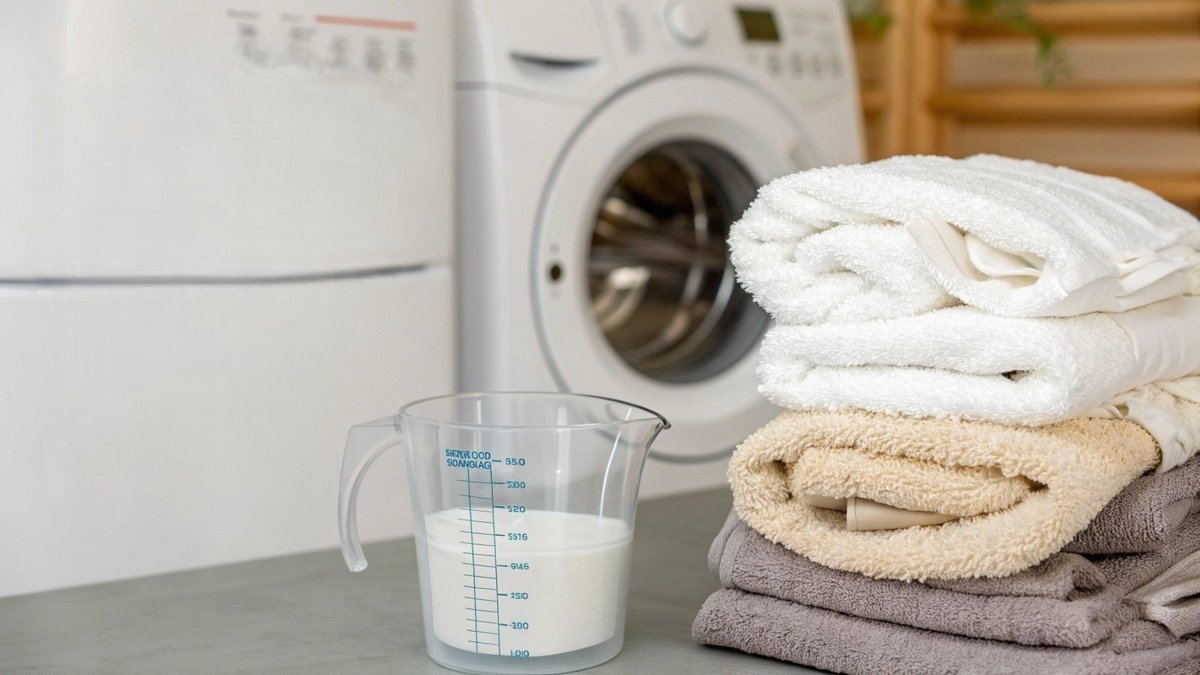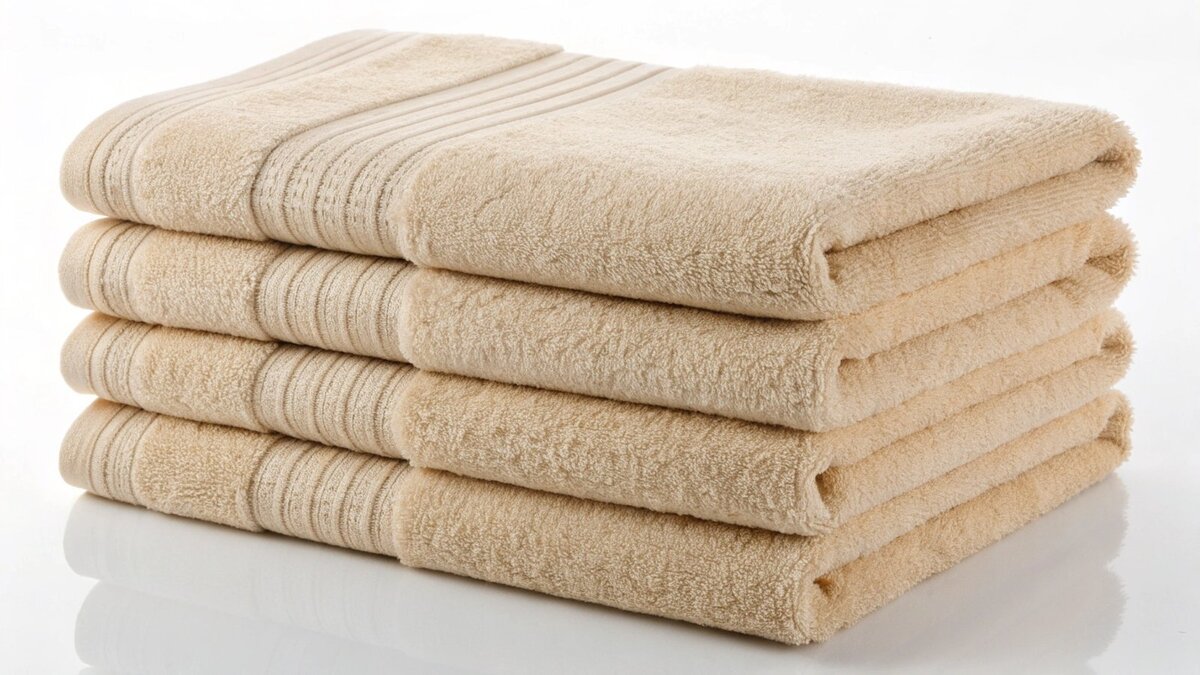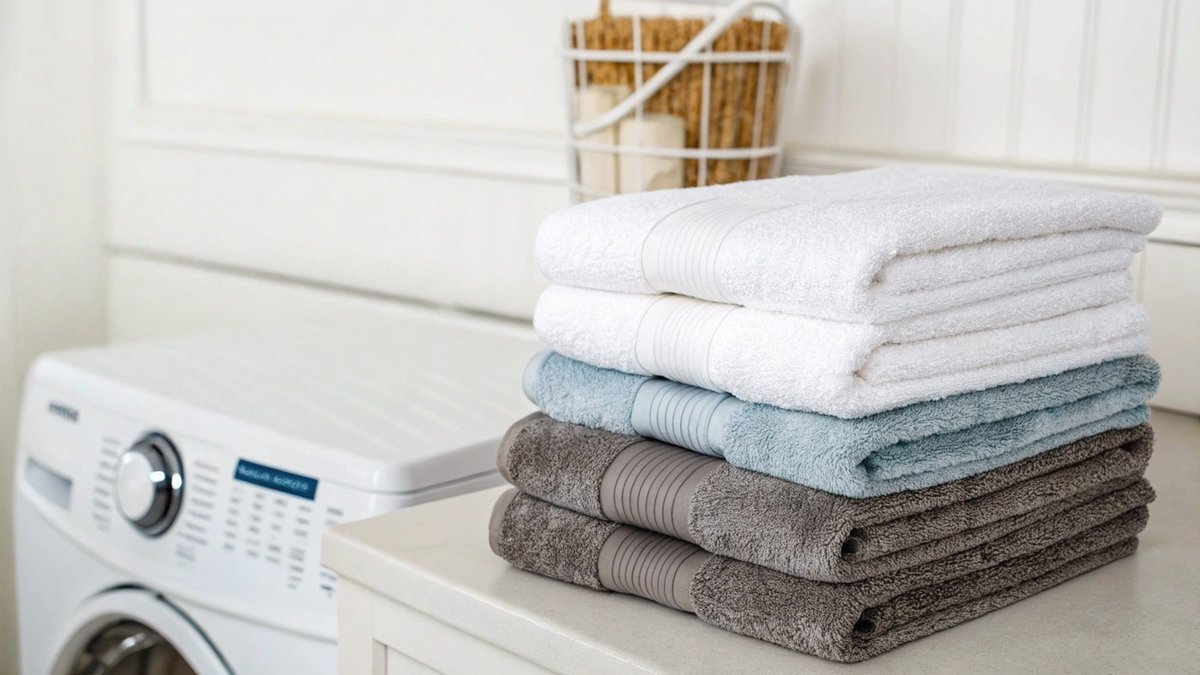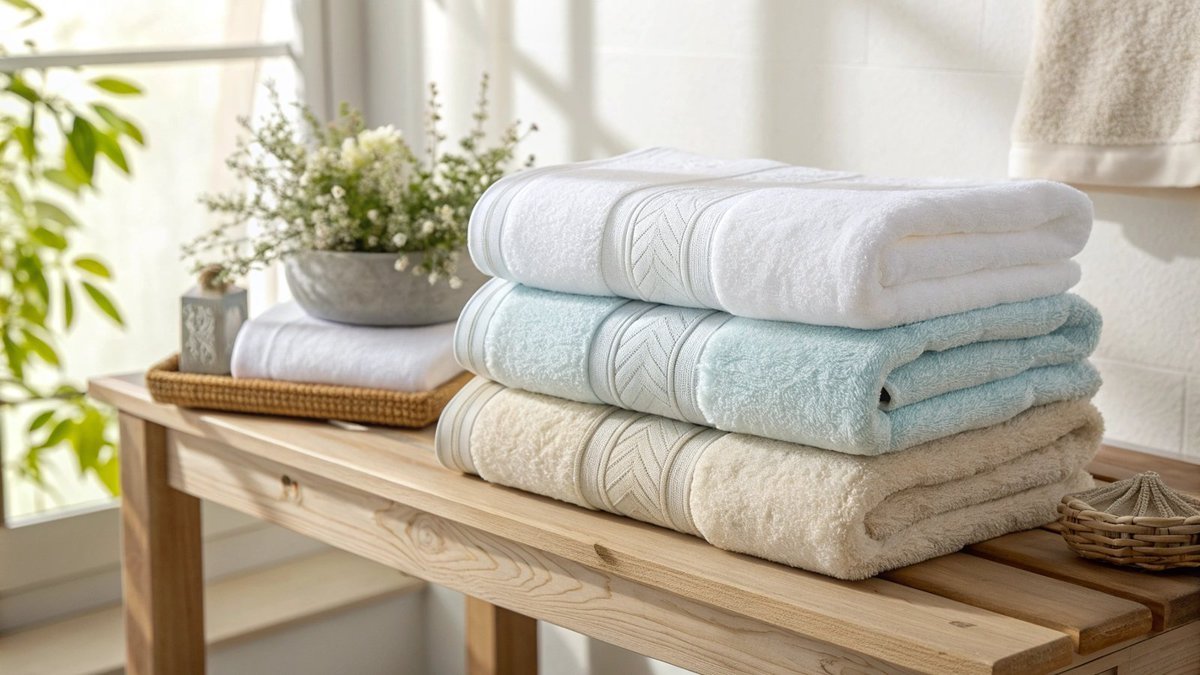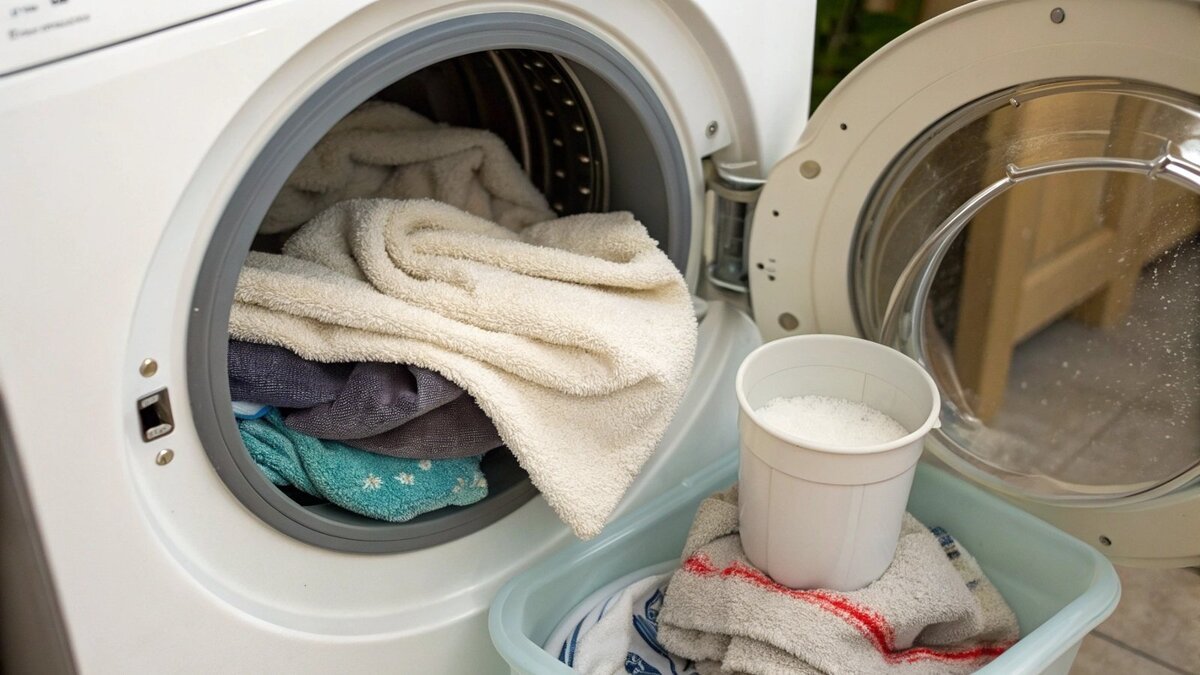Tired of finding fuzz all over your skin after a shower? It’s frustrating when a new towel leaves more behind than it takes off. But there are simple ways to fix it.
The best way to stop towels from shedding is to wash them before the first use with one cup of white vinegar in the rinse cycle. Tumble dry on a low heat setting and avoid fabric softeners, which can worsen shedding. Investing in towels made from long-staple cotton also minimizes shedding from the start.
Now you know the quick fix for annoying towel lint. But understanding why your towels are shedding is the key to preventing it in the future. Let’s look at the reasons behind the fuzz and the specific steps you can take to get a perfect, lint-free dry every time. Keep reading to become a towel expert.
Why do my towels leave fuzz on me?
You step out of the shower, grab a fresh towel, and start to dry off. But now, you’re covered in tiny bits of lint. It’s annoying and makes a clean towel feel cheap.
Towels leave fuzz on you because of loose, short fibers left over from the manufacturing process. This is especially common in towels made from lower-quality, short-staple cotton. These short fibers break easily and stick to your damp skin, creating that frustrating lint.
The fuzz you see is a direct result of the raw materials and how the towel was made. As a manufacturer, I’ve seen firsthand how fiber choice impacts the final product.
The Role of Cotton Fiber Length
Not all cotton is created equal. The biggest factor in shedding is the length of the cotton fibers, also known as the "staple."
- Long-Staple Cotton: Fibers like Egyptian or Pima cotton are long, strong, and smooth. When they are spun into yarn, there are fewer tiny ends sticking out. This creates a durable, soft towel that is much less likely to shed.
- Short-Staple Cotton: This is a more common and less expensive type of cotton. The fibers are short and break more easily. Towels made from this material will almost always shed more, both initially and over their lifetime.
I remember a client who wanted to launch a budget-friendly towel line. They opted for short-staple cotton to keep costs down. Within a month, their customer reviews were full of complaints about "fuzz balls" and "endless lint." For their next production run, we switched them to a mid-grade long-staple cotton. The price per unit was slightly higher, but the negative reviews about shedding disappeared completely.
| Fiber Quality | Shedding Potential | Why It Happens |
|---|---|---|
| High (Long-Staple) | Low | Strong, long fibers are tightly spun and resist breaking. |
| Low (Short-Staple) | High | Weak, short fibers break easily during washing and use. |
How many times do you have to wash towels before they stop shedding?
You’ve washed your new towels once, twice, even three times, but the lint keeps coming. You start to wonder if they’ll ever stop shedding. You just want to use your towels without the hassle.
High-quality towels made from long-staple cotton should stop shedding after 1-2 washes. However, lower-quality towels might need 5-10 wash cycles to significantly reduce shedding, and some may never completely stop due to the continuous breaking of their short fibers.
The number of washes needed is a good indicator of your towel’s quality. A few washes to remove manufacturing residue are normal, but excessive, prolonged shedding points to a problem with the material itself.
The First Few Washes Are Critical
The initial washes are your best opportunity to control shedding. Follow a specific process to get the best results.
- First Wash: Wash your new towels with other towels of a similar color. Do not add detergent for this very first wash. Instead, add one cup of white vinegar to the rinse cycle. The vinegar helps to set the colors and starts breaking down any coatings from the factory, which helps release loose fibers.
- Washes 2-3: Shedding should be noticeably less. You can now wash with a small amount of gentle detergent. If you still see a lot of lint, you can repeat the vinegar rinse.
What to Expect Over Time
For a standard, mid-range towel, most of the excess production fibers will be gone after a couple of washes. By the fifth wash, you should see very little lint in your dryer’s trap. If your towels are still shedding heavily after 5-10 washes, it’s a sign that the cotton fibers themselves are weak and breaking down. At that point, no amount of washing will completely stop it. At TowelTrend, we advise all our clients to include care instructions that mention washing before use. It sets the right expectation for the end customer and ensures the towel performs its best from day one.
Why does so much lint come off my towels?
You open your dryer after a load of towels, and the lint trap is completely full. You wonder where it all comes from and if your towels are just falling apart. It feels wasteful and messy.
A large amount of lint comes from new towels shedding loose fibers left over from production. If it continues with older towels, it’s because the cotton fibers are short, weak, and breaking down from heat, friction in the dryer, and harsh chemicals like fabric softener.
While some initial lint is normal, a non-stop lint storm is a clear warning sign. It’s often caused by how you care for the towels just as much as what they’re made of.
Fabric Softener Is Not Your Friend
This is the most common mistake I see people make. Fabric softeners, both liquid and dryer sheets, work by coating the fibers with a waxy, water-resistant film. This film does two negative things:
- It Reduces Absorbency: The waxy coating repels water, which is the opposite of what a towel should do.
- It Increases Shedding: The slick coating makes the fibers slippery. This lubrication can actually cause the loosely-bound, shorter fibers to work their way out of the weave more easily, creating more lint.
A few years ago, we worked with a hotel that was complaining their luxury towels were losing absorbency and creating too much lint for their laundry service. We discovered they were using a heavy-duty fabric softener in every load. We advised them to switch to using white vinegar in the rinse cycle as a natural softener. The result? The towels became more absorbent, and lint production dropped by over 60%.
Your Dryer Settings Matter
High heat is another enemy of cotton towels. It essentially "bakes" the fibers, making them brittle and prone to snapping. Those broken pieces become lint. Always tumble dry your towels on a low or medium heat setting. It may take a few minutes longer, but your towels will last longer and shed far less.
How do I get my towels to stop shedding?
You already own shedding towels and don’t want to replace them just yet. You need a practical, step-by-step solution to get the fuzz under control. It’s frustrating, but you don’t have to give up.
To get towels to stop shedding, wash them separately in warm water with a half-cup of baking soda. Then, run a second rinse cycle with one cup of white vinegar. Tumble dry on low heat and clean the lint trap halfway through the cycle.
This process is designed to remove loose fibers and strengthen the ones that remain, drastically reducing the amount of lint you see. By adjusting your laundry routine, you can manage shedding from almost any towel.
Your Step-by-Step shedding Reduction Plan
For the best results, follow these steps methodically. It might seem like a lot at first, but it quickly becomes a simple routine.
- Wash Towels Separately: Always wash towels in a load by themselves. This prevents lint from getting on your clothes and stops friction from other fabrics from pulling out more towel fibers.
- Don’t Overload the Machine: Give your towels plenty of room to move around in the washer. A crowded load doesn’t get rinsed properly, leaving behind both detergent and loose lint.
- Use the Vinegar & Baking Soda Method:
- Place your towels in the washer with a half-cup of baking soda. This helps scrub the fibers clean. Use a normal amount of gentle detergent.
- When the rinse cycle begins, add one cup of white vinegar. This strips away any residue and helps lock the fibers into the weave.
- Manage Your Drying:
- Shake each towel out vigorously after taking it out of the washer. This physically dislodges loose fibers before they go into the dryer.
- Dry on low or medium heat.
- Clean your lint trap before you start, and if it’s a large load, consider pausing the dryer halfway through to clean it again.
When we develop a new towel for a private label brand, our QC team runs it through a series of wash-and-dry cycles specifically to measure shedding. This confirms the yarn quality is up to standard. As a buyer, you can do your own version of this test by aggressively washing a sample before placing a bulk order. It tells you everything you need to know about its long-term quality.
Conclusion
Stopping towel shedding comes down to smart washing techniques, like using vinegar and low heat. But for a truly lint-free experience, the best strategy is always choosing high-quality, long-staple cotton towels from the start.

